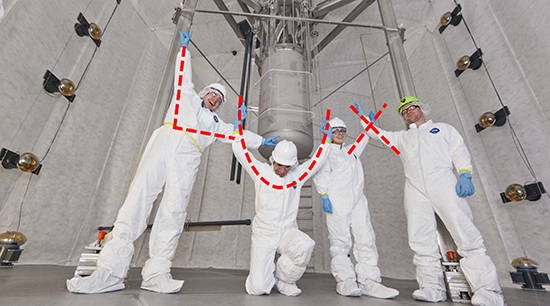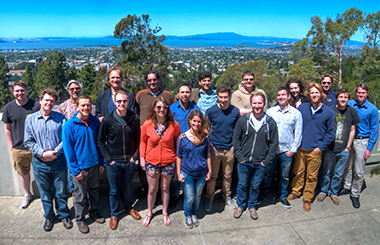Dark Search in the Black Hills
 |
|
Scientists in the underground Large Underground Xenon (LUX) experiment pose playfully with the LUX dark-matter detector, filled with 600 pounds of liquid xenon. At right is UAlbany postdoctoral scientist Jeremy Mock. |
ALBANY, N.Y. (August 15, 2016) — How does a 20-month string of missed shots become a victory? When it teaches you where not to aim.
This was the conclusion reached by the Large Underground Xenon (LUX) dark-matter experiment, conducted beneath a mile of rock in the Black Hills of South Dakota. In its final 20-month-long run completed this May, the LUX detector did not find the dark matter it was hoping to find. But thanks to enhancements furthered by UAlbany physicist Matthew Szydagis, LUX is ready for an upgraded stage of stalking what is thought to be the dominant form of matter in the universe.
Szydagis, whose refinement of analysis and use of computer simulations helped improve LUX’s sensitivity significantly from its initial run in 2013, represented the project and presented its results for the first time in the United States at the 38th International Conference on High Energy Physics on Aug. 6 in Chicago.
Scientists believe dark matter, estimated to make up nearly 27% of the mass and energy driving the galaxies of the universe, might be a kind of particle. LUX and other dark-matter experiments being conducted across the globe, are trying to find direct evidence of its existence.
“LUX has delivered the world’s best search sensitivity since its first run in 2013,” said Rick Gaitskell, professor of physics at Brown University and co-spokesman for the LUX experiment. “With this final result from the 2014-2016 search, the scientists of the LUX Collaboration have pushed the sensitivity of the instrument to a final performance level four time better than the original project goals, offering critical guidance for the next generation of dark matter experiments.”
 |
|
An international team of researchers gather at a LUX analysis workshop in Berkeley, Calif. UAlbany's Matthew Szydagis is in the front row, extreme left, while postdoctoral scholar Jeremy Mock is fifth from the right in the front row (gray sweatshirt).
|
The international scientific team working on the project at the Sanford Underground Research Facility in South Dakota, said Szydagis, is confident “that if dark matter particles had interacted with the LUX’s xenon target, the extreme sensitivity of the detector would almost certainly have seen it.”
These findings have enabled the team to eliminate many potential models for dark matter particles, offering critical guidance for the next generation of dark matter experiments, which includes the LUX-ZEPLIN (LZ) experiment. LZ will supplant LUX at the Sanford facility, and Szydagis and its other scientists expect the new experiment to achieve 70 times the sensitivity of LUX.
Szydagis is the ‘Level-3 Manager’ for development of LZ’s data analysis software algorithms. His Department of Physics postdoctoral scholar Jeremy Mock, who worked with him on LUX to provide critical computer simulation inputs, will manage LZ’s cleanliness protocols while also working on innovative new systems to further reduce the chances of getting false positives from WIMPs (weakly interacting massive particles), the leading theoretical candidate for a dark matter particle.
The LUX scientific collaboration, supported by the U.S. Department of Energy and National Science Foundation, includes 20 research universities and national laboratories in the United States, the United Kingdom and Portugal.
“LUX has done much more in terms of its sensitivity and reliability than we ever expected it to do,” Gaitskell said. “We always want more time with our detectors, but it’s time to take the lessons learned from LUX and apply them to the future search for dark matter.”
![]() For more news, subscribe to UAlbany's RSS headline feeds
For more news, subscribe to UAlbany's RSS headline feeds
A comprehensive public research university, the University at Albany-SUNY offers more than 120 undergraduate majors and minors and 125 master's, doctoral and graduate certificate programs. UAlbany is a leader among all New York State colleges and universities in such diverse fields as atmospheric and environmental sciences, business, education, public health,health sciences, criminal justice, emergency preparedness, engineering and applied sciences, informatics, public administration, social welfare and sociology, taught by an extensive roster of faculty experts. It also offers expanded academic and research opportunities for students through an affiliation with Albany Law School. With a curriculum enhanced by 600 study-abroad opportunities, UAlbany launches great careers.


